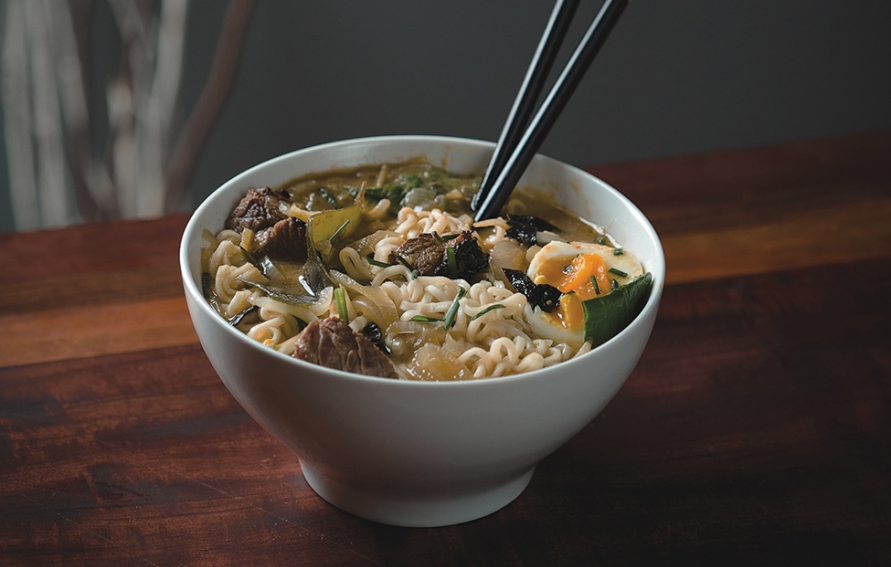About this recipe
One Hundred Years of Ramen
Instructions
FOR THE RAMEN NOVICE: SHOYU RAMEN WITH PORK BELLY, LOCAL GREENS AND EGG
Makes 5 generous servings (with leftovers)
- 4 quarts chicken broth (organic)
- 1 large piece peeled ginger, sliced into rounds (about ½ cup )
- 6 garlic cloves, peeled and smashed
- 1 small onion, quartered
- ¼ cup soy sauce
- 1 piece dried kombu (edible kelp found in the Japanese section of an Asian market; look for organic)
- 2 tablespoons mirin (a Japanese cooking wine that is lower in alcohol and sweeter than typical cooking wines)
- 2 pounds pork belly (2 pieces)
- 3 tablespoons soy sauce stirred with 2 tablespoons brown sugar
- 1 pound curly ramen noodles (available in most grocery stores)
- 5 handfuls baby spinach or other greens (think spinach, pea shoots, baby kale from the farmers’ market)
- 5 soft-boiled eggs, peeled and sliced in half (the fresher and more local, the better; free-range eggs have beautifully rich orange yolks )
- Green onions, sliced thin
- Nori sheets, sliced into thin strips (dried seaweed with a toasted, salty flavor, commonly used for sushi; available at Asian markets)
Combine the chicken broth with the ginger, garlic, onion, soy, kombu, mirin and pork belly.
Bring to a gentle simmer. Cook pork belly 30 minutes, then remove to a cutting board. Continue simmering the broth.
Cut pork into ¼-inch slices, place on a lined baking sheet and brush with the soy sauce and sugar mixture. Place under a low broiler and cook until crispy and dark brown. Remove and set aside.
Strain the broth and keep very hot.
Bring a pot of water to a rolling boil. Cook noodles according to package directions. Drain and immediately divide among bowls. Place a handful of spinach, 4–5 slices of pork and 2 egg halves in each bowl. Ladle broth over top of each bowl and garnish with green onions and nori strips. with a toasted, salty flavor, commonly used for sushi; available at Asian markets)
FOR THE RAMEN VETERAN: SHOYU RAMEN WITH PORK BELLY, LOCAL GREENS AND MARINATED EGGS
Makes 5 generous servings (with leftovers)
- 5 marinated and boiled eggs, sliced in half (recipe follows)
Follow the recipe for the Ramen Novice and replace the soft-boiled eggs with the marinated eggs.
For Marinated Eggs
- 5 eggs ½ cup soy sauce
- ½ cup mirin
- ¼ cup sugar (preferably organic)
- Cook eggs, cool and peel.
Place in a glass bowl with soy sauce, mirin and sugar. Be sure eggs are completely submerged.
Refrigerate for 6–12 hours. Slice and serve in hot soup.
FOR THE RAMEN EXPERT: SHOYU RAMEN WITH HOMEMADE BROTH, PORK BELLY, SEARED BROCCOLINI AND MARINATED EGGS
Make your own broth for this version. Follow the recipe for the Ramen Veteran with the marinated eggs. Add the seared broccolini and enjoy.
Makes 5 generous servings (with leftovers)
For Better Broth
- 1 pound chicken wings (preferably organic)
- ½ cup dried mushrooms
- 1 quartered onion
- 1-inch piece sliced ginger
Combine chicken wings, dried mushrooms, quartered onion and ginger in a large stockpot. Bring to a boil, reduce to a simmer and cook for 2½ hours, occasionally skimming any fat. Cool, strain and discard the solids, then refrigerate overnight. Skim off (most) of the fat before proceeding with the recipe.
For Seared Broccolini
- ½ pound broccolini
- 1 tablespoon sesame oil
Slice each broccolini stem in half. Heat 1 tablespoon sesame oil over a medium flame, then add broccolini. Cook until deeply browned on the bottom and bright green on top.
Seasonal Toppings Bar
Customizable toppings are part of the ramen experience and make it especially fun for family dinners and party. Seasonal toppings can be pre-chopped, put in finger bowls and set on the table with little spoons or tongs. Here are some seasonal spring toppings:
- sliced radishes
- sliced blanched asparagus
- slivered fiddleheads
- sliced garlic scapes, green garlic, ramps
- slivered snow peas
- roasted new potatoes
- roasted and sliced parsnips
- braised wild mushrooms
- toasted sesame seeds
- pickled ginger
- sriracha sauce
- bean sprouts
- chopped herbs (cilantro, basil are favorites)




